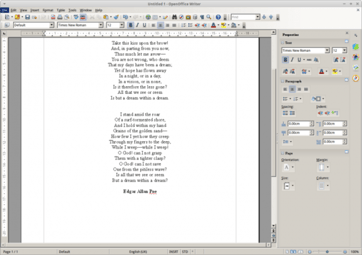FOSS - Free and Open Source Software
Open Source - An application whose programming code, or source, is open to the public in order to view, modify, or create plugins for the application.
Back in the days of early computing, the only way to get games, office applications, and other software was to go to the nearest electronics or media store and pay for a physical copy of the software.
However, many individuals found fault with this kind of software model and felt that the source code and the applications themselves should be free and open in order to encourage creativity and communication. That was how the Open Source movement started.
Today there are literally thousands of applications which can take up the task of paid software freely available to download and run. It is my goal to cover some of these programs in the hopes that it will save people time, money, and will encourage a new level of creativity for them.
This is my second post in this series, please see the first post: FOSS Application - The GIMP.
Today’s FOSS Application(s): Open Office and Libre Office
Today my readers get a two-for-one special of FOSS software! The reason? Both Open Office and Libre Office stemmed from the same parent project at OpenOffice.org . Open Office’s development was taken over by a company called Oracle and then later to Apache, while Libre Office split off and continued to be independently developed. At the end of the day, both of these office suites are excellent viable replacements for Microsoft Office or Apple’s iWork.
Before I delve into these two suites too deeply, I want to note that, while both suites are very similar in nature due to the same parent project, there are some differences between them. For example, Open Office can only import the current Microsoft Office formats, while Libre Office can both open and save in them. There are also some small in fonts, features, and other kind of items within the individual suite components. Lastly, certain Microsoft Office Excel macros will not work within these office suites so, users who use macros should be aware of that when importing or opening Excel sheets in Open Office or Libre Office.
Open Office and Libre Office are office productivity suites aimed at being effective replacements for Apple and Microsoft’s offerings. Both suites come fully loaded with the kind of core applications that many businesses and individuals have come to rely on for their everyday productivity tasks. Please see the comparison list below:
Writer - Word
Calc - Excel
Impress - Powerpoint
Base - Access
In addition to these standard office applications, Open Office and Libre Office also come with additional applications such as Draw -a quick illustration and graphic design application, Math - an application for formula creation, and a slew of various template and project files available online to get the user started.
The great thing about the core applications is that for the most part, they do play well with Microsoft Office formats. The default file format when a user saves their work is in one of the Open Document formats, an open standard which spans across most office suites at this point. However, the office suites can also both export to the older 97-2003 Microsoft Office file types and Libre Office can also export to the newer XML-driven Microsoft Office formats.
All of the applications within the Open Office and Libre Office suites are full-functioned and give the same level of flexibility and creativity that a user might find in other costly office suite software. Both suites are completely free to use for corporate, business, and home users, making these office suites the most affordable way to get office productivity done.
I currently use Libre Office because I find it to be a little faster and more stable than Open Office. That being said, now that Open Office’s development is in the hands of the Apache group, known for it’s Open Source web server suite, I am confident that the software will quickly catch up to it’s younger sibling in those regards. Either way, both office suites are perfect replacements for Microsoft Office and iWork.
The only thing lacking in these office suites is an email client to replace Microsoft Outlook. While there are Open Source options out there for email clients, none of these are included as part of Open Office or Libre Office. However, many users now use their smartphones and tablets for email, even in a corporate environment. It is still unfortunate that there is no included email client.
In conclusion, no matter which suite the user chooses, Open Office and Libre Office are both great ways to ensure that the user has a fully-functioned office productivity suite on their computer. This kind of software is required in order to complete most school and job productivity requirements in the world today. Both suites are available for Windows, Mac OS, and Linux.
Would a free office suite be beneficial to you or your business?
Copyright 2014 Christopher Weitzel
Featured Image Credit: By http://www.libreoffice.org/download/3-6-new-features-and-fixes/ (Libre office 3.6 start centre.png) [CC-BY-SA-3.0 (http://creativecommons.org/licenses/by-sa/3.0)], via Wikimedia Commons
In-Post Image Credit: By Apache Software Foundation (Self-made screenshot) [Public domain], via Wikimedia Commons
About the Author

Guest
We welcome guest contributors who graciously volunteer their writing for our readers. Please support our guest writers by visiting their sites, purchasing their work, and leaving comments to thank them for sharing their gifts here on CatholicMom.com. To inquire about serving as a guest contributor, contact editor@CatholicMom.com.




.png?width=1806&height=731&name=CatholicMom_hcfm_logo1_pos_871c_2728c%20(002).png)
Comments